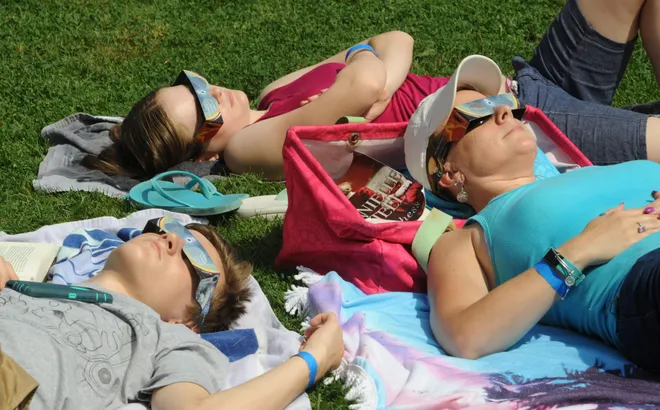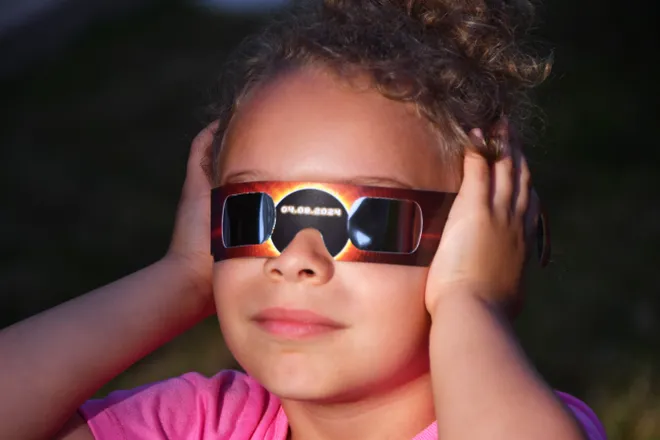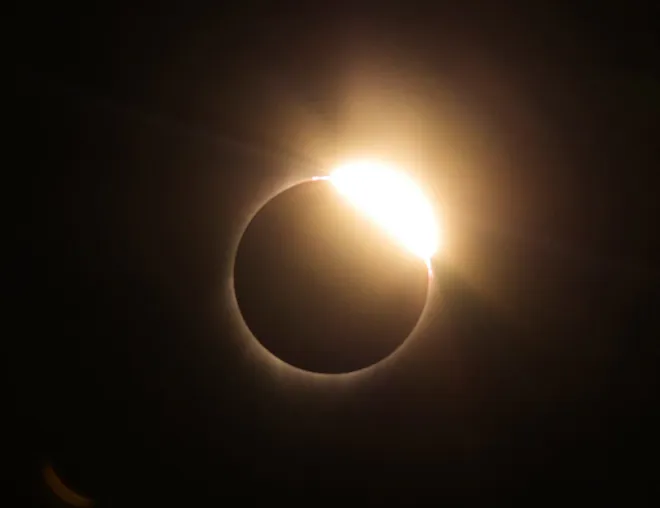Is it safe to look at a total solar eclipse? What to know about glasses, proper viewing
The much-anticipated solar eclipse will finally enshroud thousands of miles of North America today in its long, narrow shadow. By now, those who plan to witness it should have their plans in place.
Travel has been completed. Schedules have been coordinated around the anticipated moment of totality. And proper eyewear is, of course, in your possession. Right?
We at USA TODAY have published no shortage of articles guiding you away from scam eclipse glasses and to the safest, most reliable options – some of which were even free. But if you need a last-minute refresher – or a crash course to catch you up on a topic you entirely missed – we're happy to oblige.
If you don't have your eclipse glasses by now, it may be too late. But some vendors, including Warby Parker, and even public libraries, have offered eclipse glasses giveaways, so be sure to check your local area before the historic event rolls into town.
And if you do have your eyewear to take in Monday's eclipse – the last one of these incredible astronomical events in North America for 20 years – here are some last-minute things to consider to ensure you're in good shape.
Solar eclipse 2024 live updates:See latest weather forecast, what time it hits your area

Can you go blind by looking at the solar eclipse?
Staring at the sun is unlikely to completely blind you, but its powerful rays can still burn and damage your retinas if you don't take proper safety precautions to view solar eclipses.
That's why eyewear is recommended if you plan to look up at the sun Monday to witness the solar eclipse, which most of the country will be able to experience in some way.
In the face of the sun's powerful rays, regular sunglasses made of cheap plastic and polycarbonate material just aren't going to cut it. Astronomers and other experts instead emphasize that skygazers intent on viewing the upcoming total solar eclipse do so with specialized eyewear crafted to protect their sensitive retinas from permanent damage.
Even viewing any part of the bright sun through camera lenses, binoculars and telescopes without a specialized solar filter could instantly cause severe eye injury, according to the American Astronomical Society.
Often made with a polyester film coated in aluminum, the glasses are highly specialized. Compared to regular sunglasses, proper eclipse glasses are 100,000 times darker to block nearly all visible, infrared and ultraviolet light and protect our sensitive retinas when looking skyward.
As another point of safety, don't look up while driving, please.
How to know when it's safe to view the eclipse without glasses
A total solar eclipse offers the unique opportunity for skygazers to witness the spectacular astral display with the naked eye – but only when the time is right.
Hundreds of cities in 13 states are along the path of totality for the eclipse, which will move across North America from southwest to northeast. When the moon moves completely in front of the sun and blocks its light for a brief period of time, you'll know it's safe to fully take in the dazzling display.
That moment is what is called "totality," whereby uncharacteristic darkness falls and all but the sun's outermost layer known as its corona makes a rare appearance to us here on Earth, according to NASA.

How to make sure your eclipse glasses aren't fake
In the rush to acquire some coveted eclipse glasses before April 8, you may have inadvertently fallen victim to the fakes and imitators proliferating online retailers.
While plenty of legitimate certified eyewear was widely available – and may still be – less-scrupulous manufacturers try all sorts of methods and tricks to get your attention and make you believe the product you're about to buy is the real deal.
For instance, many vendors began making the grand (and entirely made-up) claim that their products are endorsed by NASA.
As the space agency reiterated to USA TODAY, NASA highly recommended that skygazers get a pair of certified eclipse glasses before the total solar eclipse charts a 115-mile-wide path of totality blanketing much of North America in uncharacteristic darkness. But it does not approve any particular brand of solar viewers, despite what many vendors may claim.
The responsibility of guiding American consumers to the safest eclipse glasses is largely left to the American Astronomical Society.
The organization maintains a curated list of approved vendors of solar eclipse glasses that it updated to give priority to North American manufacturers ahead of the total solar eclipse. Products you purchase that are listed on that site are guaranteed to be in compliance with the highest international safety standards.
Those standards are set by the International Organization for Standardization, which only vouches for solar eclipse glasses that are dark and strong enough to filter out a certain amount of the sun's harmful light.
The astronomical society also provides some helpful tips for how to spot counterfeit glasses.

No eclipse glasses? Welding lenses, pinhole projectors among alternative viewers
While certified solar eclipse glasses are the preferred method for viewing the eclipse, alternative methods do exist that don't necessarily sacrifice one's safety.
Many people, particularly blue-collar workers, may be tempted to turn to those welding lenses they have sitting in their workshop.

But beware: The most common welding goggles and helmets aren't typically strong enough to adequately withstand the sun's powerful rays and protect your vulnerable eyes.
Any welding lenses weaker than a Shade 12 filter – a number that indicates the level of protection offered – just aren't going to cut it when it comes to gazing upward in anticipation of the moon blocking all but the sun's outermost layer.
It's also not too late to buy some welding lenses, which Tractor Supply is promoting for sale at its 282 stores along the path of totality as a viable option for viewing the eclipse.
Another simple method is to create your own pinhole projector to project the sun onto a nearby surface. The American Astronomical Society offers helpful instructions to set them up.
And one final note: As you make your eclipse-viewing plans, these interactive maps should help you chart the time and duration for when totality would occur in cities along the path.
Eric Lagatta covers breaking and trending news for USA TODAY. Reach him at elagatta@gannett.com
Disclaimer: The copyright of this article belongs to the original author. Reposting this article is solely for the purpose of information dissemination and does not constitute any investment advice. If there is any infringement, please contact us immediately. We will make corrections or deletions as necessary. Thank you.




